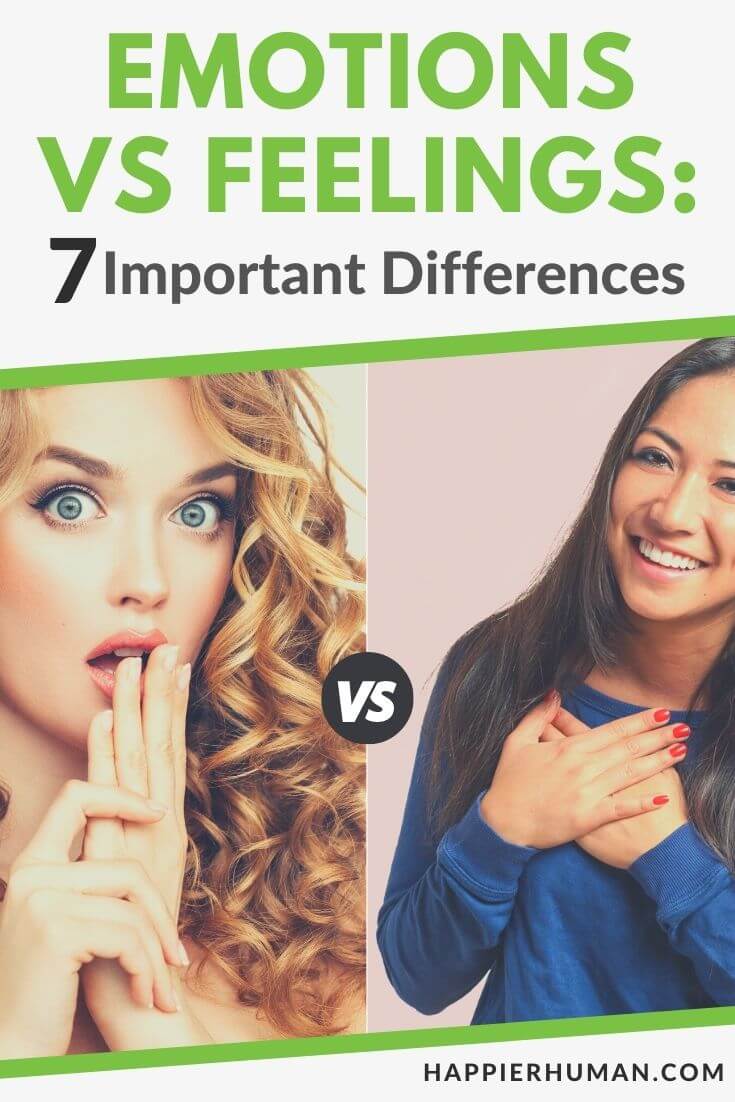Emotions. Feelings. We use these words to talk about our sensations, but they aren't quite the same. Are you surprised? It came as a surprise to me, too. Not to mention, I thought “surprise” was a feeling.
Although feelings and emotions are closely related, it's crucial not to mix them up when expressing what is going on in your brain or body. I decided to dig into some articles on emotions vs feelings and share my findings on their differences.
I hope that by the time you're finished reading this article, you'll appreciate the reasons why it's important to tell them apart.
What are Emotions?
According to the American Psychological Association (APA), there is no well-accepted definition for the term “emotions.” The absence of a clear definition has interfered with research on the subject. Notwithstanding, emotions broadly refer to psychological responses to events and situations.
The response is usually subjective and determined by whatever it is that triggers (or stimulates) the emotion, also called the stimuli. For instance, receiving good news can cause you to experience happiness, while feeling threatened can trigger fear. Common emotional triggers include an event, person, place, object, memory, or anything that stimulates the five senses.
Emotions can also be pleasant or unpleasant and range from mild to intense.
Types of Emotions
The classifications of emotions by psychologists Paul Ekman and Robert Plutchik stand out the most. In 1972, Ekman suggested these six basic and universal emotions:
Ekman later included embarrassment, shame, excitement, amusement, satisfaction, trust, pride, and contempt as other core emotions. It was Plutchik's suggestion that emotions can be mixed (like colors) to create other types, or secondary, emotions. For example, happiness + anticipation = excitement.
Mixed emotions
It isn't uncommon for us to experience mixed emotions in different situations. Finding out you're pregnant can cause you to feel happy about becoming a mom yet fearful about not knowing what to expect during pregnancy. There's a possibility you may feel both emotions at the same time or one after the other.
Shifting emotions
Some people experience a range of emotions on any given day. You may have witnessed someone experience disgust, anger, joy, and sadness all on the same day. People diagnosed with mood disorders, for example, alternate between being extremely happy (mania) and extremely sad.
What are Feelings?
The APA defines feelings as sensations resulting from emotions, and there's a long list of them compared to the number of emotions researchers have identified. Like emotions, those experiences are subjective, meaning each individual perceives and processes them differently.
That helps explain why the same emotion can cause different feelings in different people. On top of that, you can have mixed and shifting feelings.

The APA added that emotions are distinct from feelings, mood, and affect, even though people use those words interchangeably. It's not surprising in the case of emotions vs feelings, since there's a thin line between the two.
Furthermore, some researchers suggest that feelings can be both an emotional experience and a physical sensation. As you can imagine, their point of view fueled the debate on whether feelings and emotions mean the same thing. Once you go over the key differences, you'll be able to tell one apart from the other.
7 Key Differences Between Emotions and Feelings
When it comes to emotions vs feelings, there's a thin distinguishing line, so it's not unusual to feel confused about them. Interestingly, some people prefer to say “emotional feelings,” and more than 300,000 were collected in a single study. To make it easier for you to grasp the important differences between them, I will explain 7 things emotions are that feelings generally are NOT.
1. Emotions are psychological reactions.
Emotions arise in certain regions of the brain, such as the amygdala and prefrontal cortex, in response to internal or external stimuli, also called triggers. The amygdala becomes activated in response to emotions such as fear, which can lead to feelings such as stress and anxiety. Feelings, on the other hand, represent the way humans experience whatever emotion is activated.
Added to that, our thinking process is influenced by whatever emotions we're experiencing. The more intense they are, the less able we are to think clearly and logically. Chances are you've heard someone say we should avoid discussions on sensitive matters when emotions are running high. Notice the difference in your tone of voice and mannerism when you're happy.
2. Emotions trigger physiological responses.
You can't help but notice that emotions also cause strong, intense physiological reactions known as feelings. Emotions activate or deactivate certain systems in the body in preparation for action. For example, fear causes the body to go into stress mode (fight or flight response). The body then produces a stress hormone called cortisol.
Stress is a survival mechanism as it helps you deal with harm or the threat of harm. Heart rate also increases or you may begin to experience fear symptoms, such as sweating, anxiousness, and panic. Responses, such as blushing or feeling like you have to use the bathroom may accompany other types of emotions.
Here's another example. Experiencing sadness on behalf of someone who is ill or homeless might cause you to sense empathy. The feeling arises from an innate ability to sense how others might feel and makes you want to help the person out of their situation.
3. Emotions create different feelings.
It is well-established that emotions are “raw data.” Psychologist, Rachel Allyn Ph.D., agrees and stated these real-time data are sparked by sensations in the body. What this seems to suggest is that feelings do not exist on their own.
Each emotion triggers a range of feelings in kids and adults alike. Without emotions, humans are unable to experience spinoff effects such as annoyance from anger or excitement from happiness. Allyn further explained that thoughts come into play and affect how each of us feels those emotions.
Another observation is the same emotion can result in different feelings depending on who's experiencing it.
Let's say you and your friend disagree over a sensitive issue like gender equity. You might leave the conversation after experiencing anger (emotion). Your anger might feel like frustration because you think your friend talks over you to get their opinions across quickly. On the other hand, your friend's anger might feel like irritation because they think you're arrogant and always dismiss their opinions.
Both of you experience the same emotion, but your feelings differ on the basis of how you perceive what takes place during the conversation.
4. Emotions influence behavior.
Behaviors can be physical expressions or actions that suggest how we feel. A smile indicates happiness, while a frown suggests the person is sad or angry. Again, we interpret these expressions based on our unique cultural norms and beliefs.
The way we behave is also linked to the emotion we're experiencing. A person might yell out of anger, drink alcohol out of sadness, or isolate themselves because of fear.

When the COVID-19 pandemic hit, the CDC recommended social isolation to help curb the spread of the virus. Although social distancing is no longer as strict, there are people who continue to remain in isolation for fear of catching COVID. Viewed from a different angle, fear is a survival emotion that helps keep us safe in certain situations.
On the positive side of things, we choose to get involved in pleasurable activities based on the emotions they evoke. Going on dates or hanging out with friends creates happy emotions. However, the desire for a sense of happiness and well-being can cause people to engage in destructive behaviors, such as drug use and reckless sex. These behaviors only create a false and fleeting sense of well-being.
5. Emotions are short-lived.
An emotion is usually an intense but short-lived experience, which helps explain why many people struggle to accurately identify their emotions. They disappear as fast as they come.
On the other hand, feelings can linger for a long time. For example, grief over the death of a loved one is an expression of sadness that can last for years.
Anger is another grief emotion that is short-lived but can lead to prolonged feelings of hopelessness and depression later on. Emotions tend to have a definite and identifiable cause compared to feelings, which can be difficult to identify unless you can, first, pinpoint the emotional source.
6. Emotions affect mental health.
Our psychological state is influenced by positive and negative emotions. Similarly, our emotional state impacts our overall mental health. Those who experience more positive emotions, such as happiness and love, tend to enjoy better physical and mental health.
Experiencing negative or unpleasant emotions such as anger, fear, and sadness frequently or for a prolonged period is an underlying reason for several mental disorders. Chronic fear may lead to anxiety and panic attacks. Long-term sadness often results in hopelessness, loneliness, isolation, and depression.
7. Emotions can exist on their own.
“Raw data” is the description given to emotions. Like any other type of data, we need to perform an analysis to make sense of the information. On this basis, emotions can remain just that if we don't take things a step further to identify and label them as a particular feeling. Choosing to experience anger and letting it go without attaching feelings, like resentment, to it is one example.
On the other hand, there needs to be an emotion first before you can develop a related feeling. Although this view seems accurate in theory, I can't help but wonder what kind of humans we would be if we weren't able to feel our emotions and make sense of them.
Think of emotionally unavailable people. They have difficulty opening up, trusting, and feeling feelings. Incidentally, these are all vital for building trusting and loving relationships.
Other Theories on Emotions
Again, there is no real clear-cut definition of emotions, and researchers arrived at different conclusions about what they really are. The James-Lange theory holds that our emotions are the products of our physical responses.
Example: If you spot a poisonous creature, your heart rate will likely increase. The rise in heart rate is attributed to fear and the activation of your body's fight or flight system.
However, The Cannon-Bard theory rebuts the James-Lange theory, suggesting emotional and physical responses happen at the same time.
According to the Schachter-Singer theory, emotions are the by-product of our thoughts. In other words, you cannot experience a particular emotion unless you think of something that triggers it. For instance, your controlling and physically abusive ex shows up at your home uninvited. You think of it as a threat and begin experiencing fear as a result.
Does it Really Matter to Know the Difference Between Emotions and Feelings?
Yes. If there's still any confusion, think of emotions as the parents and feelings as the children. Another distinction to note is that we experience emotions and feel feelings. They work together, whether at the same or separate moments, to shape our overall experience at any given time.
Understanding what emotions are and how they influence feelings and behaviors can help you to navigate life with more confidence. Here are three benefits of differentiating between the two.
Helps promote self-awareness
A lot of people have difficulty pinpointing their exact emotions, let alone expressing the plethora of feelings that might follow. The fact that they are fleeting in nature doesn't help much.

Self-awareness is a form of emotional intelligence that makes it easier to identify, feel, process, and understand your sensations and responses. You're able to make better decisions once you understand how and why you feel what you feel.
Self-awareness helps inform your actions toward yourself and others.
May improve mental health
The ability to identify emotions vs feelings can promote mental health and overall well-being. Since emotions tend to be short-lived, developing the skills to cope with them until they pass can contribute to more positive outcomes.
Meanwhile, practices such as mindfulness and meditation teach you how to sit with negative emotions, such as fear, until they subside. You'll also learn the importance of remaining neutral by not labeling or judging your sensations. Another mindfulness activity to consider is journaling to process and filter out related sensations, such as nervousness and confusion.
Can Influence behavioral changes
Experts believe emotions motivate change to avoid negative feelings associated with a particular behavior. For example, accidentally drinking spoiled milk leaves you feeling disgusted. To avoid that feeling in the future, you carefully check the expiration date on the product label, every single time, before consumption.
Final Thoughts on Important Differences Between Emotions and Feelings
For the avoidance of doubt, feelings are not emotions but sensations that arise. Whenever you're stimulated or aroused, ask yourself, “Is this a feeling or an emotion?” Remember your sensations may differ from someone else's, based on the label you attach to that emotion in a particular circumstance.
Now that you can tell the difference with greater confidence, you have the power to respond in ways that support physical and mental health. Make it a habit to do more things that stimulate happiness and other positive emotions. Notice how your overall sense of well-being improves. Want to get better at knowing your feelings? Get started with 9 Feelings Charts Printables for Adults in 2022.


